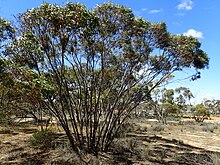Eucalyptus comitae-vallis
| Comet Vale mallee | |
|---|---|

| |
| Eucalyptus comitae-vallis near Wongan Hills | |
| Scientific classification | |
| Kingdom: | Plantae |
| Clade: | Tracheophytes |
| Clade: | Angiosperms |
| Clade: | Eudicots |
| Clade: | Rosids |
| Order: | Myrtales |
| Family: | Myrtaceae |
| Genus: | Eucalyptus |
| Species: | E. comitae-vallis
|
| Binomial name | |
| Eucalyptus comitae-vallis | |
| Synonyms[2] | |
|
Eucalyptus brachycorys Blakely | |
Eucalyptus comitae-vallis, commonly known as Comet Vale mallee[3] or Cowcowing mallee,[4]: A2 is a mallee that is endemic to the south-west of Western Australia. It has rough, flaky to ribbony bark on the trunk and larger branches, smooth withish bark above, linear to narrow lance-shaped adult leaves, flower buds in groups of seven to eleven, white flowers and barrel-shaped, conical or cup-shaped fruit.



Description
[edit]Eucalyptus comitae-vallis is a mallee, rarely a tree, that typically grows to a height of 2 to 7 metres (7 to 23 ft) and forms a lignotuber. The bark is rough, ribbony and grey on the trunks and larger branches then smooth and pinkish grey yellow-green above. Leaves on young plants and coppice regrowth are dull, greyish, 55–80 mm (2.2–3.1 in) long and 10–20 mm (0.39–0.79 in) wide and always have a petiole. Adult leaves are linear to narrow lance-shaped, the same more or less glossy green on both sides, 60–100 mm (2.4–3.9 in) long and 6–15 mm (0.24–0.59 in) wide on a petiole 8–15 mm (0.31–0.59 in) long. The flower buds are arranged in groups of seven, nine or eleven in leaf axils on a peduncle 6–12 mm (0.24–0.47 in) long, the individual buds on a pedicel 2–6 mm (0.079–0.236 in) long. Mature buds are cylindrical to narrow pear-shaped, 5–6 mm (0.20–0.24 in) long and 3–4 mm (0.12–0.16 in) wide with a rounded to flattened operculum with a short beak. Flowering occurs from February to April and the flowers are white. The fruit is a woody, barrel-shaped to conical or cup-shaped capsule 5–8 mm (0.20–0.31 in) long and 5–7 mm (0.20–0.28 in) wide on a pedicel 2–8 mm (0.079–0.315 in) long and with the valves at rim level.[3][5][6]
Taxonomy
[edit]Eucalyptus comitae-vallis was first formally described in 1923 by Joseph Maiden from a specimen collected from Comet Vale by John Thomas Jutson. The description was published in Maiden's book, A Critical Revision of the Genus Eucalyptus.[7][8] The specific epithet (comitae-vallis) is the latinised version of the type location.[9]
In 1934, William Blakely described Eucalyptus brachycorys but the name is considered by the Australian Plant Census to be a synonym.[2]
Distribution
[edit]Comet Vale mallee is mainly found between Menzies and Kalgoorlie in the Mid West, Wheatbelt and Goldfields-Esperance regions of Western Australia where it grows in sandy-clay-loamy soils in open shrubland.[3][6]
Conservation status
[edit]This eucalypt is classified as "not threatened" by the Western Australian Government Department of Parks and Wildlife.[3]
See also
[edit]References
[edit]- ^ Fensham, R., Laffineur, B. & Collingwood, T. 2019. Eucalyptus comitae-vallis. The IUCN Red List of Threatened Species 2019: e.T133375078A133375080. https://dx.doi.org/10.2305/IUCN.UK.2019-3.RLTS.T133375078A133375080.en. Downloaded on 22 September 2021.
- ^ a b c "Eucalyptus comitae-vallis". Australian Plant Census. Retrieved 3 May 2019.
- ^ a b c d "Eucalyptus comitae-vallis". FloraBase. Western Australian Government Department of Biodiversity, Conservation and Attractions.
- ^ "Environment Protection and Biodiversity Conservation Act 1999 (EPBC Act) Approved Conservation Advice - Appendices for the Eucalypt Woodlands of the Western Australian Wheatbelt" (PDF). Department of the Environment. Retrieved 22 January 2023.
- ^ "Eucalyptus brachycorys". Euclid: Centre for Australian National Biodiversity Research. Retrieved 4 June 2020.
- ^ a b Chippendale, George M. "Eucalyptus comitae-vallis". Australian Biological Resources Study, Department of the Environment and Energy, Canberra. Retrieved 3 May 2019.
- ^ "Eucalyptus comitae-vallis". APNI. Retrieved 3 May 2019.
- ^ Maiden, Joseph (1923). A Critical Revision of the Genus Eucalyptus (Volume 6). Sydney: Government Printer. pp. 431–432. Retrieved 3 May 2019.
- ^ Francis Aubie Sharr (2019). Western Australian Plant Names and their Meanings. Kardinya, Western Australia: Four Gables Press. p. 167. ISBN 9780958034180.
Text is available under the CC BY-SA 4.0 license; additional terms may apply.
Images, videos and audio are available under their respective licenses.

